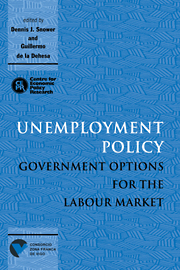Book contents
- Frontmatter
- Contents
- List of figures
- List of tables
- Preface
- Acknowledgements
- List of conference participants
- 1 Introduction
- PART ONE GENERAL POLICY ISSUES
- PART TWO DEMAND MANAGEMENT AND SUPPLY-SIDE POLICY
- PART THREE SUBSIDISING EMPLOYMENT AND TRAINING
- 6 The simple economics of benefit transfers
- Discussion
- Discussion
- 7 Wage subsidy programmes: alternative designs
- Discussion
- Discussion
- 8 Technological development, competition from low-wage economies and low-skilled unemployment
- Discussion
- 9 Macroeconomic and policy implications of shifts in the relative demand for skills
- Discussion
- 10 Would cutting payroll taxes on the unskilled have a significant impact on unemployment?
- Discussion
- 11 Preventing long-term unemployment: an economic analysis
- Discussion
- Discussion
- PART FOUR LABOUR MARKET REGULATIONS
- PART FIVE POLICY, JOB REALLOCATION AND THE UNEMPLOYMENT–PRODUCTIVITY RELATION
- PART SIX COMPARING UNEMPLOYMENT POLICIES
- Index
7 - Wage subsidy programmes: alternative designs
Published online by Cambridge University Press: 07 September 2010
- Frontmatter
- Contents
- List of figures
- List of tables
- Preface
- Acknowledgements
- List of conference participants
- 1 Introduction
- PART ONE GENERAL POLICY ISSUES
- PART TWO DEMAND MANAGEMENT AND SUPPLY-SIDE POLICY
- PART THREE SUBSIDISING EMPLOYMENT AND TRAINING
- 6 The simple economics of benefit transfers
- Discussion
- Discussion
- 7 Wage subsidy programmes: alternative designs
- Discussion
- Discussion
- 8 Technological development, competition from low-wage economies and low-skilled unemployment
- Discussion
- 9 Macroeconomic and policy implications of shifts in the relative demand for skills
- Discussion
- 10 Would cutting payroll taxes on the unskilled have a significant impact on unemployment?
- Discussion
- 11 Preventing long-term unemployment: an economic analysis
- Discussion
- Discussion
- PART FOUR LABOUR MARKET REGULATIONS
- PART FIVE POLICY, JOB REALLOCATION AND THE UNEMPLOYMENT–PRODUCTIVITY RELATION
- PART SIX COMPARING UNEMPLOYMENT POLICIES
- Index
Summary
The equilibrium volume of joblessness in the advanced economies, though it has in some countries receded a little from its high in the 1980s, far exceeds the accustomed level of the early postwar decades. In the USA and the UK, for example, the natural unemployment rate has been estimated to be around 6½ per cent in the mid 1990s. In France and Italy it stands around 8 per cent. The bulk of this equilibrium rise in aggregate unemployment is adequately explained in terms of a broadbased slowdown in the demand for labour in the face of a lesser slowdown in the general wage level required for effective worker performance as the income from private wealth and especially social entitlements barely slackened; the increased tax wedge between employers' cost of labour and employees' net wage falls into a third category, as do restrictions on hiring and firing.
As usually happens in slumps of macroeconomic origins, the relative position of disadvantaged workers – those who, for whatever reason, have poor earnings prospects over their entire lives, not just in their youth – has worsened alongside the aggregates. Joblessness is always heaviest among those workers at the lowest rungs of the labour market ladder, of course. (Although the disadvantaged, which are heavily drawn from racial minorities and recent immigrants, account for little of the unemployment in countries where they are a small proportion of the labour force, the unemployment rate among generally disadvantaged subpopulations tends to be much higher than the general unemployment rate in Europe as well as elsewhere.)
- Type
- Chapter
- Information
- Unemployment PolicyGovernment Options for the Labour Market, pp. 206 - 244Publisher: Cambridge University PressPrint publication year: 1997
- 9
- Cited by



